
|   |

|   |
 e-mail: ukb7@rediffmail.com Is classical dance changing guard? Photos courtesy: Kalamandalam Kolkata May 10, 2018 UNESCO has a healthy habit of reserving 24 hours for everything in the field of performing arts, so it is perhaps no surprise that there is an annual World Dance Day on April 29. It has been earmarked as a celebration for anyone who attaches "value and importance" to dance, and "acts as a wake-up call for governments, politicians and institutions which have not yet recognized its value". While this sounds just a little bit overboard, one would be surprised at how many places still frown upon, or outright ban, the act of dancing. Even in the open society of the USA, strict Southern Baptists do not dance, and this led to the famous work of Chicago teen Ren McCormack, who overcame the community through the medium of dance in a hard-hitting 1984 documentary, Footloose. Nearer home, Kolkata has the "creative" dancers of the metropolis using the prime location of Rabindra Sadan to offer kudos to the World Dance Day and render their presentations. But surprisingly, as ruefully observed by Somnath Kutty (who directs the venerable Kalamandalam Kolkata for past 50 years), "The Rabindra Sadan celebrations normally exclude the classical dancers, so much so, that the latter tend to forsake their classical genres and present make-shift 'creative' forms at that venue!" World Dance Day presented on April 29 in Kolkata by Kalamandalam, comprised refreshingly just eleven classical dance groups, for a change. While noticing their performance, this critic also asked what the young classical dance choreographers looked forward to on this World Dance Day in terms of their rich heritage of given strengths: rigorous techniques, preponderantly mythological themes and traditional treatments. Did they contemplate changes - of any kind by way of "a wake-up call" - or did they seek to stick to their accustomed forte? After the invocations - - a sonorous Ganesh Vandana by Sukumar Kutty and a solemn hymn by Asimbandhu Bhattacharya - the programme began with Bharatanatyam presentation by Kalakarma Foundation. Theirs was a tillana in raga Paraj, followed by Gopalakrishna Bharati's well known Nadanam Adinar..., with four dancers depicting Shiva's Ananda Tandava in the Golden Hall of Chidambaram Temple. The choreographer Rahul Dev Mandal - - with 20 years' exposure to Rukmini Devi Arundale's style of dance - responded to this critic, saying: "I believe in meditation over Nritya Yoga and try to pursue a viewpoint transcending the mythological bindings. Otherwise, my tradition has provided me the safety of my form and I find it dependable enough." 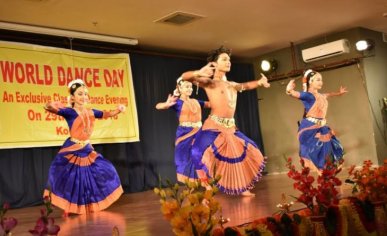 Kalakarma Foundation 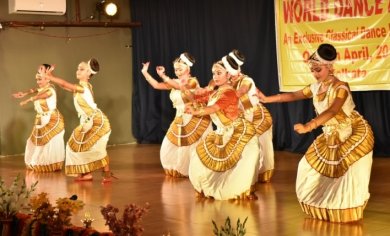 Nrityabritti Batayan 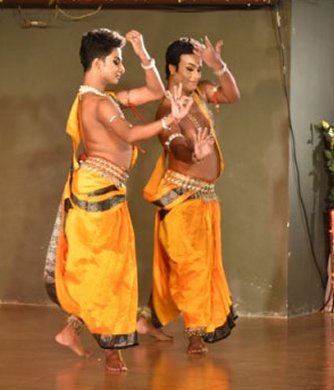 Srijan Chhanda 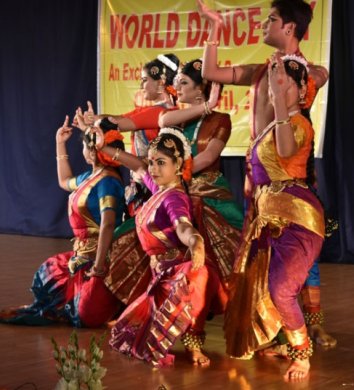 Udok Performing Arts The second presentation by Srijan Chhanda was in Odissi style launching Bankim Chandra's national song Vande Mataram in raga Desh, composed by Suman Sarkar and danced in unison by six dancers, etching vigorous patterns on stage. This was followed up by an energetic Shiva Vandana Jata chhabi..., visualising Ravana's foray into battle, composed in raga Shiva Mangala. The group's choreographer was Rajib Bhattacharya - whose grooming by Sharmila Biswas had been followed by internship under guru Kelucharan Mohapatra and his son Ratikant. Responded Rajib, "I believe in the eternal message conveyed by classical dance: in terms of literature, music, et al. I would love to build on its firm base with new thoughts that occur to me!" The third offering was by Nrityabritti Batayan from Durgapur in Mohiniattam style. Six well-trained female dancers followed up a traditional Stuti with a Tagore lyric Sangachhadhwam samvadadhwam samvo manaansi jaanataam... adapted from Rig Veda. Said their choreographer Swarnadeepa Mohanta (trained at Kerala Kalamandalam for 9 years), "My conviction is that the new generations should get acquainted with the traditional music and choreography." The fourth presentation was by Udok Performing Arts in Bharatanatyam style. Their six dancers began with a Tillana in raga Hindolam, with music by Sudha Raghunathan, followed by the scintillating Shiva Stuti composition by Dayanand Saraswati: Bho Shambho Shiva Shambho Swayambho... in raga Bhairavi. Their choreographers were Rajeev and Moumita Saha - with 25 years dance experience beginning with Guru Abhay Pal - who opined, "We have helped Kalamandalam to organise the World Dance Day, since we are firmly in favor of the classical idiom and don't pay credence to the current craze for contemporary dance." The fifth offering was by Pushpak with six male and female dancers showcasing an outstanding Kathak performance based on mnemonics spiritedly uttered by each dancer as nagma and illustrating all the angs in pure Kathak, to the accompaniment of tabla. Choreographer Alokparna Guha (groomed by Dr Malavika Mitra from the age of 8) said, "I'm concentrating on research of the tradition and graduation of Kathak, starting right from the arena of temple precincts, absorbing the Indo-Islam essence within itself - - highly enriched at the period of Nawab Wajid Ali Shah - - and getting enriched by public performances. My studies also explore the language of dance within the periphery of theatre." The sixth presentation was by South Kolkata Gurukul in Odissi form. Three female and two male dancers performed a Pallavi in raga Simhendra Madhyamam. Choreographer Sutapa Talukdar - a student of guru Kelucharan Mohapatra for 24 years -quipped, "The current classical dance scenario is not very hopeful. My faith in pure Odissi form is visibly shaken when I find senior dancers in Bhubaneswar, Delhi and Kolkata getting swayed by commercial motivations. I also observe countless gurus emerging who are chasing the ephemera and concern for perfection is going down." The seventh presentation was by Kalamandalam Kolkata itself in Bharatanatyam idiom. Presenting Ganit Vilas by nine dancers, the item created a feeling for mathematical patterns. As Alarippu opens up anga, pratyanga and upanga, here was an attempt to create geometric patterns on stage with lines, rectangles, diagonals, circles and so on in a process of gradual blossoming. Malavika Sen - with training for 25 years under Guru Thankamani Kutty - assisted her guru for this item. Says she, "I'd love to stick to tradition, but create multiple patterns in dance on the proscenium stage for catering to the sheer number of viewers. The earlier venues of temple precincts had catered to far fewer numbers of audiences." 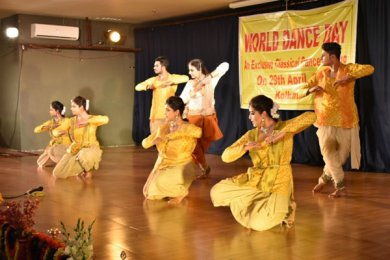 Pushpak  South Kolkata Gurukul 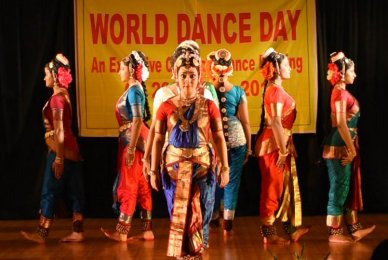 Kalamandalam Kolkata 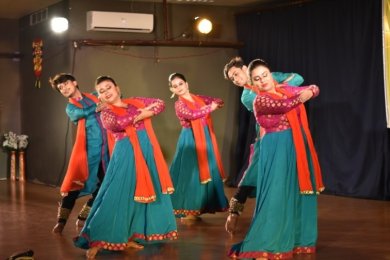 Upasana Centre for Dance The eighth offering was by Upasana Centre for Dance under Ashimbandhu Bhattacharya in Kathak style. Executed by five dancers, this was called Naba Chhanda comprising Sawari with slow counts of 1-2-3 alternating with fast counts of 1-2-3 and demonstrating angahara, dolapadma, drishtibheda, shiraveda, et al. Explained the choreographer, "I'm one-hundred-percent stickler for Kathak's authenticity. There is so much scope for bringing up innovations in my form that I don't have to look elsewhere. My experimentation only comprises in attempting how far I can take it forward after retaining its aesthetic values." The ninth presentation was by Uttarpara Parampara in Bharatanatyam form under Rajdeep Banerjee - - with initial training in Rabindra Bharati University and, later, under Gangakanti of Kalakshetra and guru C.V. Chandrasekhar. The nine dancers performed a tillana in raga Desh, on Murugan based on Lalgudi Jayaraman's composition and concluded by performing to the song Vande Mataram. Said Rajdeep, "I find dancers performing item numbers these days, after just attending sundry workshops. This is not being honest to one's chosen vocation, which deserves more professionalism. There are admittedly challenges, as found also in sports, for example, in cricket and football. Personally, I'd rather have more attention paid to costume and music." 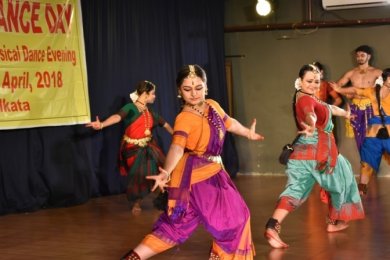 Uttarpara Parampara 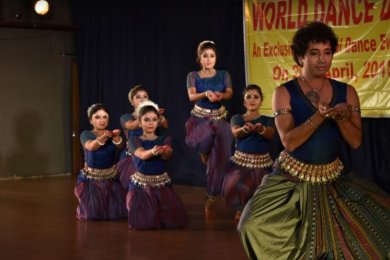 Darpani The penultimate offering was in Odissi form by Darpani choreographed by Arnab Bandyopadhyay - with a grooming for 25 years first by Sutapa Talukdar and then by Kelubabu and his son Ratikant. Their six dancers presented an engrossing fare, Ananta, based on hymns from Kathopanishad on creation with five primordial elements. Highlighting only the roles of Kshiti (earth) and Tejas (fire), their six male and female dancers visualised genesis of the world out of dark oceans and the rise of fire: Ya srishthi hi yadviram bahti vidhi hutam.... "I look forward to working with tradition, but perhaps with variation in themes. Indeed, I do wish to transit into universal themes, and not remain confined to mythological ones," commented Arnab. 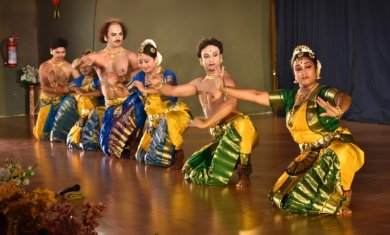 Nipun Nrityalaya The final presentation was by Nipun Nrityalaya in Bharatanatyam style, directed by Manojit Saha - trained by Anita Mallik for 10 years and by guru C.V. Chandrasekhar for 16 years. Their six dancers presented Todaya Mangalam in ragamalika and adi tala. They depicted three principal incarnations of Vishnu: Rama, Narasimha and Venkateswara, using mainly the music of Narasimha Chaturdashi. Manojit was clear in his view, "I am able to perform as a classical soloist in India and abroad, and I'm proud of this given opportunity. I do like to stick to classicism in my dance, but would look forward to new choreography. In future, I may work on thematic variety, but with an eye on their purity." On the whole, the preponderance of views - out of eleven youthful professionals heading their well established groups - seemed overwhelmingly in favor of being steadfast within the ambit of inherited tradition.  Dr. Utpal K Banerjee is a scholar-commentator on performing arts over last four decades. He has authored 23 books on Indian art and culture, and 10 on Tagore studies. He served IGNCA as National Project Director, was a Tagore Research Scholar and is recipient of Padma Shri. Comments * An extremely well written article. Thank you,Mr.Utpal Banerjee,for such a wonderful write up in Narthaki. - Somnath Kutty (May 17, 2018) * Respected Mr. Utpal K Banerjee, Thank you so much, Sir, for your lovely write up in Narthaki. I am really very lucky that my work is appreciated by you. It is very encouraging. - Monojit Saha, Nipun Nrityalaya (Oct 24, 2018) Post your comments Please provide your name and email id when you use the Anonymous profile in the blog to post a comment. All appropriate comments posted with name & email id in the blog will also be featured in the site. |